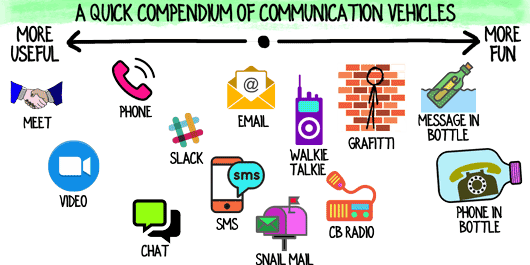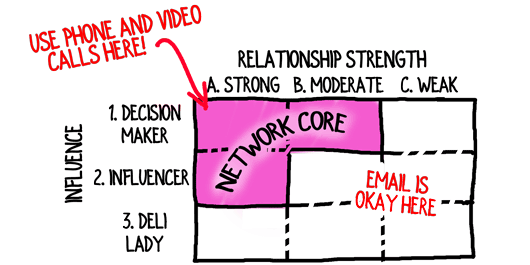Your clients and prospects need help right now, no matter what industry they’re in.
And your consulting firm has needs too. Little things like projects, revenue and Kreuther’s chocolates.

You know that your consulting firm’s contact list—clients, prospects, influencers, partners, etc.—is the lifeblood of your business and the source of a better future.
So, how do you effectively reach out to improve your consulting firm’s short-term and long-term outlook?
Literally, how? Should you text? Send a letter? Flash “Will consult for bon bons” in Morse code from a safe distance?
For that matter, consider how you decide which medium to use for any communication with your contacts.

Is it okay to formalize the scope of a consulting engagement via Slack? Should you approach relationships you’ve let lapse with elegantly calligraphed letters, as if you’re Lord Grantham of Downton Abbey?
The rules of personal interaction are in flux, and this is a good opportunity for you to reexamine how you communicate with your consulting firm’s contacts.
7 Considerations for Choosing a Communication Vehicle
Complexity
Is your message simple or multi-faceted? Government contracting regulations probably shouldn’t be sent via text.
Urgency
How important is it that your contact receive your message this instant? Is later today okay? Any time this year?
Priority
What does the vehicle you choose communicate about your message’s importance? Does a post-card scream “Drop everything!” or “Drop me to the bottom of the pile”?
Technicality
Some vehicles lend themselves to communicating precise, technical detail. Others, not so much. How technical is your communication?

Emotion
How crucial is communicating your emotional intent? What about gauging the recipient’s feelings or creating an emotional connection?
Rich vehicles (like phone, video and, eventually, in-person) are required to accurately convey feelings and intent.
Preferences
Your contacts may have expressed a desire to receive information via chiseled hieroglyphics or smoke signal. Their personal style may be low-information or high-information, and that will dictate how receptive they are to different vehicles.
That said, your clients may try to hide behind thin media like text and email. Part of your consulting firm’s value is pushing them into deeper, high-content conversations using better vehicles.
Recording
For legal or personal reasons, do you want a record of the communication? Do you want to ensure there isn’t any record?
Buying consulting services is an emotional decision, fraught with risk.
And, since virtually everyone is currently dealing with heightened anxiety, now is the time for you and your consulting firm to lean into richer communication approaches.
Pick up the phone and call your Network Core, especially your A1s.
Email is usually fine for your Network Periphery. It’s certainly better to reach out with an email than to not reach out at all!

Strive to elevate your conversations from phone or email to video for the follow-up conversation.
Video calls need to be arranged in advance; however, they’ve suddenly become much more acceptable and are, by far, the best medium outside of in-person meetings to build relationships.
What else do you consider when you’re determining how to reach out? How are you communicating to your contact list now?
Text and images are © 2024 David A. Fields, all rights reserved.

 David A. Fields Consulting Group
David A. Fields Consulting Group 

The pressing question about video calls is whether you have to be fully dressed or only the part on camera
The other option for today’s article was video-call etiquette. Maybe we’ll post that next week.
To your point, though, I thought the question was whether it’s okay to hold in front of the camera a picture of a good looking person and pretend it’s you.
Let’s find out next week…
In the meantime, thanks for prompting the subject, Derek!
Hi David!
As always, your post brought a smile to my face.
Hope you and yours are safe and well!
Wendy
Wendy, you’ve provided a perfect example of using the vehicles at hand to communicate. Case in point: responding on blog posts! (Somehow, that medium didn’t occur to me when I was playing with the illustration.)
It’s always good to hear from you, Wendy, and I’m glad you shared your voice today!
Most of my contacts do not (cannot) have their phones forwarded to their personal phones and many do not have corporate-issued mobile phones. So it could present a good opportunity to acquire that number – although such a request might often be inappropriate. Otherwise, you’re in the growing pile of emails.
You’re facing an interesting situation, Douglas, and one I had not considered. A company with personnel working at home who have no access to telephone sounds like a company that needs a lot of consulting help!
If the only way to contact someone on the phone is to use their personal phone, then requesting that number (along with the explanation of why that’s the only solution) strikes me as reasonable.
Great puzzle you’ve posed, Douglas. Thank you!
Yes– call people!!! Video calls are even better, but you need to schedule in advance.
I like your matrix (as usual). For those folks in the “call” zone, use technology to set up calls, not replace them.
You are 100% right on the mark, Reuben. Technology can be used to create distance or to bridge gaps. Par of our role (and our path to success) as consultants is to model bridge building.
I’m very glad you highlighted that idea, Reuben.
Do you suggest we call them or set an appointment first?
Good question, Dan. You don’t need an appointment to call someone. You do need one to be on video with someone. At some point, you may not even need an appointment to initiate a video call, but for now you do.
What you definitely don’t need to do is email someone to set up a phone call. Just call! If they’re not available, they won’t pick up. You can follow up with an email, of course.
Thanks for asking that question, Dan–a lot of consultants are wondering about what you asked.
Another great way is a quick pre-call text. Particularly for your A1’s.
A quick, “hey just thinking about you, do you have 15 min today to catch up”, usually get’s a response like “thanks for reaching out, call me after 3:00”. You can send 10 texts in less than 5 min. Even if you don’t talk, you get credit for caring and thinking of them.
The pre-call text can be a great strategy with certain types of people (skews younger and higher tech). Since they’re A-level relationships, the text is less likely to be seen as an intrusion.
10 texts in 5 minutes, yielding a handful of video calls is a terrific goal that most consultants can achieve at least once a week. Thanks for sharing that approach, Chuck.
Great info as usual, David. Reminder that recording the call may require the consent of all parties, depending on the location of the participants. Lots of recorded Zoom calls are happening these days without a statement that it is being recorded. Yes, the red button in the corner is lit, but not everyone knows notices it or knows what it means.
Good point, Erin. For some reason, Zoom automatically turns on recording in some situations–even if your default settings are to not record. You’re absolutely right that everyone should be notified when they’re being recorded. I’m glad you highlighted that delicate point, Erin.